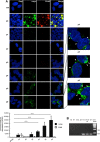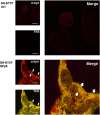Defined α-synuclein prion-like molecular assemblies spreading in cell culture
- PMID: 24898419
- PMCID: PMC4064824
- DOI: 10.1186/1471-2202-15-69
Defined α-synuclein prion-like molecular assemblies spreading in cell culture
Abstract
Background: α-Synuclein (α-syn) plays a central role in the pathogenesis of synucleinopathies, a group of neurodegenerative disorders that includes Parkinson disease, dementia with Lewy bodies and multiple system atrophy. Several findings from cell culture and mouse experiments suggest intercellular α-syn transfer.
Results: Through a methodology used to obtain synthetic mammalian prions, we tested whether recombinant human α-syn amyloids can promote prion-like accumulation in neuronal cell lines in vitro. A single exposure to amyloid fibrils of human α-syn was sufficient to induce aggregation of endogenous α-syn in human neuroblastoma SH-SY5Y cells. Remarkably, endogenous wild-type α-syn was sufficient for the formation of these aggregates, and overexpression of the protein was not required.
Conclusions: Our results provide compelling evidence that endogenous α-syn can accumulate in cell culture after a single exposure to exogenous α-syn short amyloid fibrils. Importantly, using α-syn short amyloid fibrils as seed, endogenous α-syn aggregates and accumulates over several passages in cell culture, providing an excellent tool for potential therapeutic screening of pathogenic α-syn aggregates.
Figures






References
-
- Wakabayashi K, Yoshimoto M, Tsuji S, Takahashi H. Alpha-synuclein immunoreactivity in glial cytoplasmic inclusions in multiple system atrophy. Neurosci Lett. 1998;15(2–3):180–182. - PubMed
-
- Tu PH, Galvin JE, Baba M, Giasson B, Tomita T, Leight S, Nakajo S, Iwatsubo T, Trojanowski JQ, Lee VM. Glial cytoplasmic inclusions in white matter oligodendrocytes of multiple system atrophy brains contain insoluble alpha-synuclein. Ann Neurol. 1998;15(3):415–422. doi: 10.1002/ana.410440324. - DOI - PubMed
Publication types
MeSH terms
Substances
LinkOut - more resources
Full Text Sources
Other Literature Sources
Molecular Biology Databases
Miscellaneous

